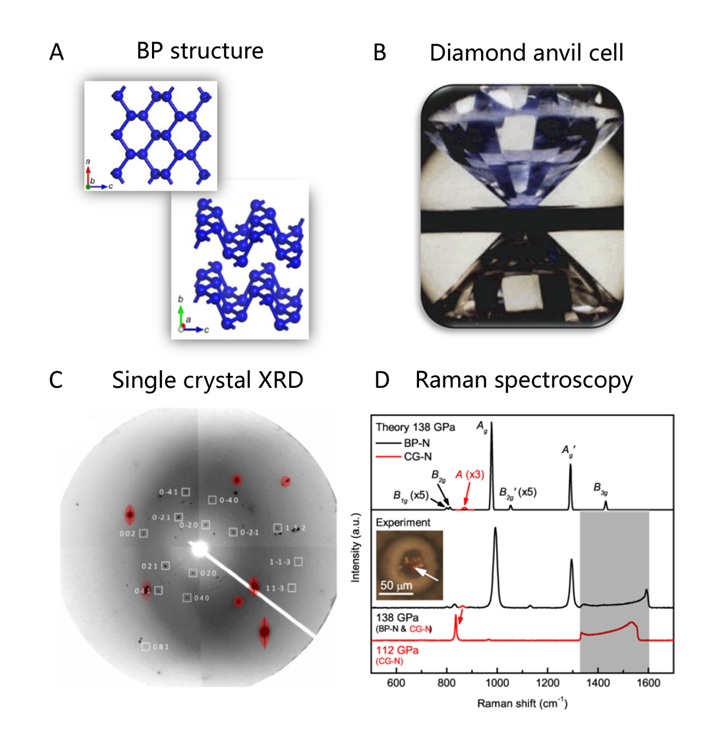Scientists Discovered a Long-sought-after Allotrope of Nitrogen in Black Phosphorus Structure - Drs. Cheng Ji, Huiyang Gou and Ho-Kwang Mao
JUNE 5, 2020
An international team co-led by Ho-Kwang Mao and Huiyang Gou from Center for High Pressure Science and Technology Advanced Research (HPSTAR) and Yansun Yao from University of Saskatchewan discovered that nitrogen, usually consisting of diatomic molecules, can form an extended structure under the conditions of 1.5 million atm pressure and 1,900 °C. In the new structure, all nitrogen atoms are connected with single bonds, similar to phosphorus atoms in black phosphorus (BP). This finding provides prospects for nitrogen-based two-dimensional (2D) materials. The results were recently published in Science Advances.
Graphene, or single layer of graphite, has a set of novel properties which has drawn tremendous attentions since its discovery. Nitrogen is the next neighbor to carbon in the periodic table of elements. Naturally, a question to ask is whether nitrogen can form a 2D material similar to graphene. On the face of it, it is difficult to imagine such a nitrogen layer since nitrogen has one more electron than carbon, overwhelming the bonding requirement of graphene. However, all elements in the VA group but nitrogen do possess allotropes with layered structures. The difference is that these VA elements have buckled layers (Figure 1A), where the surplus electrons are stored in non-bonding pairs (lone pairs). The covalent bonds connecting all VA atoms and the repulsion among lone pairs on each atom have a delicate competition and this determines how atoms are arranged in crystal structure. Phosphorene is a typical 2D material derived from the buckled honeycomb layers of black phosphorus. It exhibits a number of unusual electronic, mechanical, optical, and transport properties with great potential as a prototypical next-generation 2D material. If the BP-structured nitrogen can be found, the synthesis of a nitrogen-based 2D material, or nitrogene, may become possible.
There is a rule of thumb for structural changes at high pressure, “elements at high pressure behave like the elements below them in the periodic table at lower pressures.” As the first element of VA group, nitrogen is right above phosphorus. Theoretical calculations have predicted the formation of BP-structured nitrogen at high pressure. However, nitrogen is much more difficult to be transformed into the BP structure compared to the other VA elements, since nitrogen forms N2 molecules with extremely strong triple chemical bonds. Even though nitrogen has been studied at pressures exceeding one million atmosphere (100 GPa), BP-structured nitrogen has never been reported.
“Analogous to the black, white, and red phosphorus allotropes which have similar energies and can be mutually transformed, single-bonded nitrogen at high pressure may also have multiple polymorphs that are very close in energy. Although BP-structured nitrogen is calculated not to be the allotrope with the lowest energy, we think it may be synthesized as a metastable phase at some particular pressure-temperature conditions,” said Huiyang Gou, a co-team leader at the Center for High Pressure Science and Technology Advanced Research (HPSTAR) in Beijing.
“Our molecular dynamic simulation indicates that BP-structured nitrogen becomes energetically more favorable when the temperature is raised, implying the possibility of synthesizing BP-structured nitrogen at high pressure and high temperature conditions.” said Yansun Yao, a professor of University of Saskatchewan.
The team used an apparatus called “diamond anvil cell”, to exert formidable pressure on to molecular nitrogen. A tiny nitrogen sample is squeezed between two opposite sharp diamond tips (Figure 1B), and meanwhile it is subjected to very high temperature through heating by high-power laser. They explored a large pressure range from 1.2 to 1.9 million times normal atmospheric pressure, and saw the formation of a new nitrogen phase at approximately 1.5 million times normal atmospheric pressure and 1,900 degrees Celsius. The BP structure was identified by using synchrotron based single crystal X-ray diffraction (XRD) techniques (Figure 1C), Raman spectroscopy (Figure 1D), and theoretical calculation. The new material exhibits a very special set of optical properties associated to the anisotropy of the buckled layers, in particular, colossal Raman intensity compared to other nitrogen phases. The reason for the long time absence of BP-structured nitrogen in high pressure experiment was also explained through theoretical calculations. The BP-structured nitrogen transforms back to N2 gas when the pressure is lowered. Future studies are desirable for obtaining metastable BP-structured nitrogen at ambient conditions.
“The discovery of BP-structured nitrogen is a typical showcase demonstrating the importance of fundamental scientific research at extreme conditions,” added Ho-kwang Mao, director of HPSTAR, ‘Proving the existence of a material is the very first and essential step towards applications, which may demand years or even decades of continued research efforts.”
The research team includes Cheng Ji, Liuxiang Yang, Biao Wan, Huiyang Gou, Bing Li, and Ho-Kwang Mao of HPSTAR; Adebayo A. Adeleke and Yansun Yao from University of Saskatchewan; Yue Meng, Jesse S. Smith, Wenjun Liu, and Guoyin Shen of Advanced Photon Source (APS), Argonne National Laboratory (ANL); Vitali B. Prakapenka of University of Chicago; Wendy L. Mao of Stanford University.

Figure 1. Subfigures A,C,and D are from this work [C. Ji, et al., Science Advances, 6, eaba9206 (2020)].Subfigure B is from the web http://www.physics.nmsu.edu/~kanani/dac_side_crop.jpg.
氮气是我们非常熟悉的一种气体,熟悉到它伴随着我们的每一次呼吸。但是你可曾想过,在极端高压的条件下,氮气会脱胎换骨,转变成一种我们既陌生,但又可能以其他方式与我们的生活戚戚相关的材料么?近日,北京高压科学研究中心毛河光院士、缑慧阳研究员、吉诚研究员、杨留响研究员,李冰研究员等与加拿大萨省大学(University of Saskatchewan)姚延荪教授组成的国际合作团队,在150万大气压和2200 K的极端条件下,首次发现了一种具有褶皱蜂窝层状结构的聚合氮(褶层聚合氮)。氮的这个新型同素异形体的结构与黑磷的晶体结构一致。相关结果6月3日以题为“Nitrogen in black phosphorus structure”发表在Science Advances 上,并被选为当期的四个featured article之一。褶层聚合氮的发现为氮基二维材料和高能量密度聚合氮的近一步发展奠定了基础。
